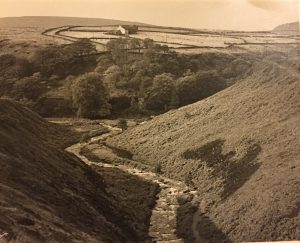
This old photo of Blake Dean was shown in the Hebden Bridge Camera Club meeting Oct 3,
The Story of Willie Wrigley
Willie Wrigley was my second cousin three times removed: James Wrigley, my gt gt gt grandad was Willie Wrigley’s great uncle.
In 1881 Willie was living on New Road Hebden Bridge. That’s the main road through town, which my living room window looks down upon directly. It’s the A646. He married Charlotte Greenwood at St John’s parish church in Halifax, now known as Halifax minster in April 1894 and six months later their daughter Gwendoline (I’ m thinking Wendolene Ramsbottom from Wallace and Gromit) was born. Two years later son George was born, 1896. By 1901 the family were living at 19 Garnett Street, Hebden Bridge – or WERE they? Willie’s name is heavily crossed out on the 1901 census for this address. Further research on the Malcolm Bull site reveals that at least on March 31st, the night that the 1901 census was taken Wille Wrigley, architect, was an overnight visitor at the Pack Horse Inn, Widdop.
m thinking Wendolene Ramsbottom from Wallace and Gromit) was born. Two years later son George was born, 1896. By 1901 the family were living at 19 Garnett Street, Hebden Bridge – or WERE they? Willie’s name is heavily crossed out on the 1901 census for this address. Further research on the Malcolm Bull site reveals that at least on March 31st, the night that the 1901 census was taken Wille Wrigley, architect, was an overnight visitor at the Pack Horse Inn, Widdop.

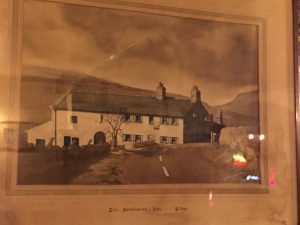
Pack Horse Inn – a photo in the pub
Oh my! Last weekend (Sep 16, 2018) I’d taken a hike around Widdop reservoir for the first time and called in for a quick drink at the very same Pack Horse Inn. It claims to be the highest and most isolated pub in the Upper Calder Valley. So yesterday I called back in at the Pack Horse and chatted to the landlord, telling him of my connection to the place. There are currently three double rooms above the pub which are being renovated so that they can be used as guest room once again. He told stories of drinking after hours in this remote pub, the guests and the publican reckoning that they were too isolated for a police raid. Drunken guests would fall asleep on the floor, under the tables secure in the knowledge they were safe for the night. I’d love to know if Willie was just a visitor for the night, or whether he was living there. In January 2004, the pub won the National Civic Pride gold standard award, as the most scenic pub in Britain, beating 200 other pubs. Besides the landlord and his family there are two visitors listed, Willie Wrigley, architect, and Marshall Sutcliffe, cab proprietor. Also on the census at the pub were two men who are classed as boarders and give general labourer as their occupation. This would therefore seem to indicate tat Willie was not a boarder, but a ‘real’ visitor. He’s 27 years old. It’s a very remote spot between Heptonstall and Widdop. Yesterday (Sep 26, 2018) I approached it from the Colne side, up a treacherous single track road, one of the steepest I’ve seen in this area. In the six miles there was one sheep and a couple of scattered lights coming from remote farmhouses – that was all. Widdop reservoir opened in 1878.

Widdop Reservoir

The water level is very low
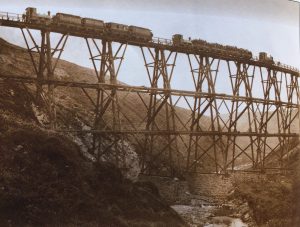
The wooden trestle bridge designed by William Henry Cockcroft. Blakedean Railway trestle bridge was 590 feet (180 m) long and 105 feet (32 m) high and consisted of pitch pine.

The stone stanchions are visible. It was completed on 24 May 1901, my birthday!

The stanchions are all that remains today of the spectacular bridge
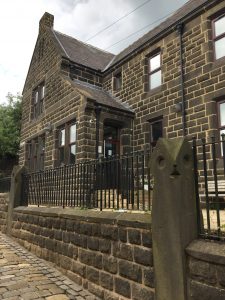
Heptonstall School
Yesterday I explored the valley where the famous railway trestle had been constructed. I was searching for the only part of the bridge that survives – the stone stanchions that formed the base of the bridge as it crossed the river, just below where the two streams meet. They are still there but the tiny track that led down to them through the russet coloured bracken was too treacherous for me so I contented myself with  taking photos from the upper track that had once formed the bed of the railway line. A nearby quarry presumably supplied the stone for the stanchions, and probably the level track on the hillside that you can see from Widdop Road, opposite Widdop Gate, held tracks that brought the stone from the quarry to the bridge site. The trestle bridge was designed by local Hebden Bridge architect and surveyor William Henry Cockcroft, and though I have Cockcrofts in my family tree I don’t presume to be related to this particular man! He and his two sons were the first passengers on the first truck to go on the bridge. Wooden huts for the workers were built at Whitehill Nook, just below Draper Lane in Heptonstall/Slack and it became quickly known as Dawson City, after the Klondike city. I’ve been fascinated by this story since first seeing photos of the shanty town in the White Swan in Heptonstall on my summer visits to the area. By the time of the 1901 census, when Willie Wrigley was staying at the Pack Horse, Widdop, ten of the workers’ huts were occupied. Wives and children moved here with their husbands and soon the impact was felt in the local community. The Board School, built by my ancestors, of course, could not accommodate the extra children and so a spare room in the school master’s house was brought into service for the additional thirty children that came from Dawson City. Sanitation in the new city was obviously going to be a major problem and even as early as February 1901 two cases of typhoid had been removed from the shanty town to the Fielden hospital in Todmorden. In 1903 smallpox broke out. The navies were required to keep their children off school. Smallpox victims were taken to the isolation hospital at Sourhall close to Todmorden and vaccinations were given and a field hospital was built at Dawson city being constructed rom a tent and capable of caring for 14 patients. But in October 1903 it blew down in a gale. In all there were 60 cases of smallpox in the Hebden Bridge and Todmorden area, but only one patient died. In 1909 a woman, Mrs Edgar Harwood, fell from the bridge after going ‘for a stroll to admire the view.’ She was well known in Hebden Bridge and ran a dressmaking a millinery business under the name Townsend (her maiden name I think) and Milnes.
taking photos from the upper track that had once formed the bed of the railway line. A nearby quarry presumably supplied the stone for the stanchions, and probably the level track on the hillside that you can see from Widdop Road, opposite Widdop Gate, held tracks that brought the stone from the quarry to the bridge site. The trestle bridge was designed by local Hebden Bridge architect and surveyor William Henry Cockcroft, and though I have Cockcrofts in my family tree I don’t presume to be related to this particular man! He and his two sons were the first passengers on the first truck to go on the bridge. Wooden huts for the workers were built at Whitehill Nook, just below Draper Lane in Heptonstall/Slack and it became quickly known as Dawson City, after the Klondike city. I’ve been fascinated by this story since first seeing photos of the shanty town in the White Swan in Heptonstall on my summer visits to the area. By the time of the 1901 census, when Willie Wrigley was staying at the Pack Horse, Widdop, ten of the workers’ huts were occupied. Wives and children moved here with their husbands and soon the impact was felt in the local community. The Board School, built by my ancestors, of course, could not accommodate the extra children and so a spare room in the school master’s house was brought into service for the additional thirty children that came from Dawson City. Sanitation in the new city was obviously going to be a major problem and even as early as February 1901 two cases of typhoid had been removed from the shanty town to the Fielden hospital in Todmorden. In 1903 smallpox broke out. The navies were required to keep their children off school. Smallpox victims were taken to the isolation hospital at Sourhall close to Todmorden and vaccinations were given and a field hospital was built at Dawson city being constructed rom a tent and capable of caring for 14 patients. But in October 1903 it blew down in a gale. In all there were 60 cases of smallpox in the Hebden Bridge and Todmorden area, but only one patient died. In 1909 a woman, Mrs Edgar Harwood, fell from the bridge after going ‘for a stroll to admire the view.’ She was well known in Hebden Bridge and ran a dressmaking a millinery business under the name Townsend (her maiden name I think) and Milnes.
Update: May 16, 2020. All these Mosses are related to me!
1909 May 2l Mrs Edgar Harwood of Hurst Dene, Birchcliffe Road HB fell to her death from the Blakedean Trestle Bridge. Mr Abraham was the foreman of the inquest jury.
Mrs Mortimer Moss and Miss Moss (Ibbotroyd) were at the funeral.
The next thing I find:
Jul 14 , 1909. (only 2 months later) Married at Wainsgate Baptist Chapel, Claude Stansfield Redman, eldest son of Richard Redman of Pleasant Villas, Hangingroyd Road, HB, and Miss Bertha Moss, youngest daughter of the late Mortimer Moss and Mrs Mary Moss of Ibbotroyd, Wadsworth. Mr Wilfred F Redman cousin of the Bridegroom was the organist and John Smith uncle of the Bride, assisted the Rev W J Hamam. The Bride was given away by her uncle Mr E Harwood of Hurst Dene, Birchcliffe Road, FIB. Best Man was James Redman (brother), Groomsmen were Richard Thomas, Henry Helliwell, and F Pickles. Three bridesmaids were Miss Martha Moss, Miss Nellie and Edythe Redman (sisters of the Bridegroom).
_____________
Wow! E. Harwood of Hurst Dene!
1909 May 2l Mrs Edgar Harwood of Hurst Dene, Birchcliffe Road HB fell to her death from the Blakedean Trestle Bridge. Mr Abraham was the foreman of the inquest jury.
Mrs Mortimer Moss and Miss Moss (Ibbotroyd) were at the funeral. That means that the woman who died was the bride’s aunt.
There’s an extensive article in the newspaper: May 28, 1909
https://www.britishnewspaperarchive.co.uk/viewer/bl/0002124/19090528/165/0007
So, getting back to Willie. The first reference I find of him is in the 1881 census when he is the 8 year old son of George and Elizabeth Wrigley who lived on New Street, Hebden Bridge. That’s the main road through the town, and the one that my apartment overlooks! George is a painter, employing 6 men and 2 boys so he’d be a well known figure in the town. I can’t find the family on the 1891 census but on 12th June 1894, he married Charlotte Greenwood at Halifax Parish Church. Charlotte was born in Mytholmroyd, the daughter of James Greenwood.
Update: May 25, 2020 I’m spending a lot of time during lockdown sorting out my photos – al 31,000 of them and during that process yesterday I found that Charlotte Greenwood, who married Willie Wrigley was born at Hill House. It took me a little time to locate it but it still at the top of a hill – hence the name!- just off Raw Lane. Raw Lane runs parallel to Burlees Lane which I explored last week for the first time and posted about. I had ancestors both at Great Burlees farm and Stephenson House on Burlees Lane. Raw Lane is just above Burlees Lane and I’d wanted to explore it so now I had a good excuse, so the weather was perfect and I set off. Raw Lasne turned out to be a lovely well preserved old road, often enclosed by trees.
At the top of the lane leading down to Hill House a man was working in his garden and I chatted to him for a few minutes explaining my mission. Then I walked down the cobbled path leading to Hill House. As is mostly the case the road side is the back of the house and I was fortunate to see a lady approaching the house from the garden and we ended up chatting for 20 minutes or so. She’s lived there for 26 years and could tell me much about the recent renovations of the house and barn. I’d discovered that Charlotte had been born there in 1871 and that her father, James Greenwood had been a farmer there with 28 acres. When the current owner moved there the same 28 acres came with the property. She brought me a framed photo of the house taken from a helicopter, just like the one my parents had of our house in Affetside. The helicopter had landed in our field to sell his print. There’s a dated stone above the font porch of 1678 and the initials IMG and she assured me that this was the date of a remodel. Perhaps the ‘G’ signifies that the house had been in the Greenwood family for many generations but when I checked online when I got back home I could find virtually nothing about the house, so I put a posting of Mytholmroyd’s history society page and I’ll see what comes from that. I had noticed that on an early census Stephenson House on Burlees lane is the next house on the census to Hill House and I got a great view of the from of Stephenson House from Hill House. From Burlees Lane I only saw the back. A very, very steep trail went directly down from Hill House into Redacre wood and I was soon back in Mytholmroyd. From Caldene avenue on my way home I had a perfect view of Hill House.
Willie established a partnership in 1894 with Joseph Frederick Walsh as Walsh and Wrigley, architects and surveyors. I’m still trying to find out where he studied. However, the business only lasted 16 months. It’s disillusion was significant enough to be noted in a London newspaper:
THE LONDON GAZETTE, MAY 5, 1896.
NOTICE is hereby given that the Partnership heretofore subsisting between us the undersigned Joseph Frederick Walsh and Willie Wrigley carrying on business together at Hebden Bridge in the county of York as Architects and Surveyors under the style of Walsh and Wrigley has been dissolved by mutual consent as from the 30th day April 1896. All debts due and owing by the said late Partnership will be received and paid by the said Willie Wrigley.—As witness our hands this 30th day of April 1896. JOSEPH F. WALSH.
Willie’s work included St Thomas of Canterbury Catholic Church, Hebden Bridge.
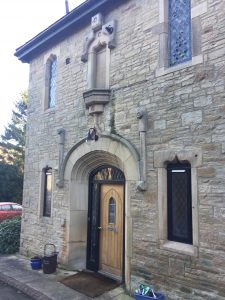
Fairfield church is now apartments. I’ve contemplated living there!
However, it would seem that as early as 1900 all is not well in the architect’s business. In the Todmorden and District News on Friday 27 April, 1900 we read that the Hebden Bridge urban council finance committee recommend the Council let the back top office over the fire brigade station to Mr. Willie Wrigley, architect, at £lO per annum.
The 1901 census, taken on the night of March 31st, lists him as a visitor to the Pack Horse, Widdop. His wife and two children are at 19 Garnett Street, Hebden Bridge. A couple of months later, in July of 1901 there is a long and detailed article in the local newspaper featuring the house in Garnett Street AND Mr Wrigley! 19 Garnett Street is and undwelling. An article in The Independent Wednesday 24 November 2004 explains this curious construction: “These underdwelling/overdwelling houses are unique to Hebden Bridge,” explains estate agent Ben Turner. “During the industrial revolution the workers needed houses. This area is very hilly and there is a shortage of land, so instead of building one terrace on the hillside, they would build a house and then build another above or below it.” The layout of Willie’s house, the underdwelling, below his landlady’s house, the overdwelling, plays a significant role in this account.
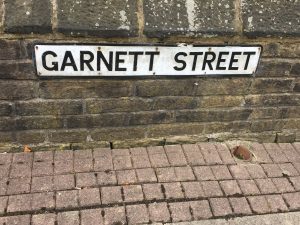
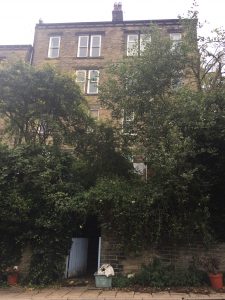
The house on the right is #19 Garnett Street. Mrs Halstead lived in the overdwelling, and the Wrigleys below it in the underdwelling.
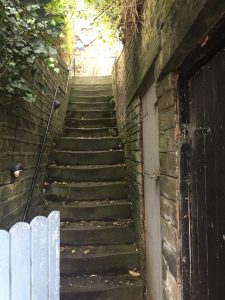
Stairs to the underdwelling at 19 Garnett Street
July 12, 1901 Todmorden and District News
The Hebden Bridge Ejectment case
At Thursday week’s Petty sessions Mrs. Mary Elisabeth Halstead. Hebden Bridge applied for order of ejectment against Willie Wrigley, architect, Garnett-street. Hebden Bridge, tenant one of her dwelling houses but the case was adjourned until Monday to enable Mr. Shaw, solicitor (on behalf of the applicant), to prove the delivery of a certain message. Mr. George Parker, solicitor, now appeared on behalf of Wrigley. At the request of the clerk Mr Shaw again presented the facts of the case, observing that the tenancy was a monthly one (by which he meant four weeks) and was determined by notice to quit given by Wrigley himself in a letter which he sent to Mrs Halstead personally. The letter ran: I hereby give you one month’s notice to deliver possession of this house, to date from May 28th next. PS —If you are agreeable this notice may date from last rent day, April 30th, and if so, I must know not later than Wednesday next.” The notice, which was delivered by a child of Wrigley’s aged from five to six or seven years, was accepted by Mrs Halstead. A reply to that effect was written by one of Mrs Halstead’s daughters, at the dictation of her mother, and handed to the child. The houses belonging to Mrs Halstead were built the slope of a hill, and Wrigley lived underneath the applicant . The later, from her window, saw the child deliver the note at its father’s house. The reply ran as follows: “I accept the notice for the 28th May and shall be pleased for you to go out on that day.” Nothing more was heard of Wrigley after the service of the statutory notice upon his wife until the 25th June, when he, along with his wife, went late at night, to Mrs. Halstead and family’s house. It happened that the whole of the family had retired for the night. However, Wrigley knocked at the door and on Mrs Halstead looking out of the window Mrs Wrigley inquired if she had gone to bed. Mrs Halstead told her that she had but eventually she came downstairs and opened the door. Wrigley and his wife then said they had come to pay the rent, but Mrs Halstead refused to take it, he (Mr Shaw) having advised her to do so. Then Wrigley said “If you don’t take the rent I will drink it and then you will know when you do get it.” Mrs Halstead replied “I want you to remove quietly,” to which Wrigley responded that they were to remove to Halifax the day following. As a result of the arrangement Mrs Halstead caused the house to be advertised as to let on May 10, 17, 24 and 31st. Mrs Mary Elizabeth Halstead, on being called, deposed that she was the owner of the house in question; that the tenancy was a four-weekly one . and the rent 4s. 6d. per week. Mr. Wrigley had been the occupier for little over two years. She remembered the letter from Wrigley, giving up possession of the house, to which she replied that she would accept it from the 28th May. She gave the reply to the little girl who brought the notice, and watched the child from her window, take it home. She did not see anything more of Wrigley or his wife until they came and woke her up. That was on the 25th June, which was the rent day. They had all retired for the night, when she heard the door bell ring. She looked out of the window and there saw Mr. and Mrs. Wrigley. On being asked what they wanted. Mrs Wrigley said she wanted to see her (Mrs Halstead) and asked her to come downstairs. She did so and Mrs Wrigley then said she wanted to pay the rent She (Mrs Halstead) said she could not accept it, am! told her to and see Mr. Shaw, the matter was entirely in his hands. Wrigley then interposed and said that she (Mrs Halstead) must take the rent. She replied “No; when are you going remove.” Wrigley responded, “We are going to remove to Halifax to-morrow.” She (Mrs Halstead) mid to that, “ I shall be pleased if you will go quietly. but the rent 1 can’t accept. Wrigley next exclaimed “If you won’t accept the rent I will spend every penny in drink and then you will know when you get it.’ Again she (Mrs Halstead) said “I shall very sorry for you to do so, but the rent I can’t take. You will have to see Mr Shaw.” That conversation took place at 10 o’clock at night – By Mr Parker: He asked me if I was willing to let him stop if there were no more rows. That was on the 14th June. Mr Shaw: What has been your experience of Wrigley as a tenant? Mr Parker: I must protest against that.—The Clerk advised the Bench that Mr. Shaw was justified in ascertaining what the conduct of the tenant had been. If disturbances had occurred and the tenant had promised not to repeat them in the future that would be taken into consideration.—Mr. Parker observed that he absolutely objected to the question ; conduct another matter altogether and had nothing to do with the contract. His point renewal or no renewal, and no condition could affect that. The conditions stated and accepted renewed the tenancy, which must be put an end to by notice. If there was any remedy for condition it was not ejectment, but rather by damages.—The Bench allowed Mr. Shaw to put his question as to the kind of a tenant Wrigley had been?—Mr. Parker asked that such should be directed to .lune 14th, and not to any prior dale. Mrs Halstead, in replv Mr. Shaw. said she objected Wrigley’s habits, which were the means of disturbing the other tenants, several times. The other tenants, particularly two maiden ladies, said they would leave if the rows continued. Wrigley was in the habit of coming home tipsy, bringing with him other men and they cursed and swore, and tumbled things about. Mrs. Wrigley had told her herself that. Mr. Parker, interposing, objected to anything Mrs Wrigley had said being brought before the Court that way.—Mrs Halstead, proceeding, said Wrigley had been told that if he went on rowing he would have to go. He had been a most disagreeable tenant and neighbour. The last time she mw him was at 2-30 on Thursday morning, when he came home with two other men and some dogs. They carried most fearfully until 4-30. then were quieter for half hour, but afterwards began cursing awl swearing again. It gave one the ladies referred to a most violent attack palpitation. The Clerk : have you not given him notice?—Mrs Halstead: We did give him notice a few months ago. but he and Mrs Wrigley came to us to ask if they might still live in the house and Mrs Wrigley came to n*k if they might still live in the house if would better. I was lenient with him. thinking would do better. —Mr. Shaw deposed to serving the statutory notice at house Wrigley. Mrs. Wrigley said she would give it to her husband when he returned adding that he was always away and that she did not know when she would see him. She never said single word as to any permission having been given on the 14th June, It was on the 20th when served the notice. John Halstead, husband of MrsHalstead, said he conversation with Mrs Greenwood (Mrs. Wrigley’s mother), who asked him if her daughter and her daughter’s husband could stay few days longer in the house as they had nowhere go. He told her he did not mind a few days if Wrigley would turn over anew leaf. Mrs Halstead acquiesced in that arrangement. By Mr. Parker: Did Mrs Wrigley say to you that if they were not out within a fortnight the arrangements would not go forward, and that they would want to stay, and did you say all right?—No.—About three days before the end of that fortnight Mrs Greenwood came see you. Did she say that they had decided to stop in Hebden-Bridge and that they wanted to renew the tenancy? This on June 14th. and did you say it would be all right? —No.— Mr. Parker, in ’addressing the Bench, submitted that the applicant had not made out her case. He admitted that the tenancy was a monthly one. The rent book, however, showed that the rent was paid regularly every two months. Mr. Wrigley. the tenant, was making arrangements to leave Hebden Bridge. and hegave notice, thinking that his arrangements would allow him leave the end of the month. He had letter accepting that, and the Bench would observe that the notice was not to run from the date which was given, but three weeks later. Therefore the notice itself would not have expired until the 25th June. He was instructed that there was no acceptance of that condition. He did not know what became of the letter Mrs. Halstead said she wrote, but if the Bench came to the conclusion that it was written, there was evidence to show that it had reached the defendant. Mrs. Wrigley would say that on June 7th Mr. Halstead went to their house and asked them why they had not left. They said they were making arrangements which they hoped to quit in a few days. He suggested that they should get out in fortnight, and they replied that they expected to do that, but Mrs Wrigley remarked that if they did not go to Nelson they would want to stop and renew the tenancy. Upon that Mr. Halstead said “ Yes, yes,” implying to her that that would be all right. The arrangements about leaving fell through. and three days before the expiration of that fortnight. Mrs Wrigley’s mother, who made the original arrangement of the tenancy, went to see Mr Halstead about it being renewed. Mrs Greenwood was unable come to court, but she had an interview with Mr. Halstead, after which she told her daughter that she had arranged with him as to the tenancy being renewed. There was no application for the rent due the 28th May. The tenancy was renewed, the notice withdrawn the consent of Mrs. Halstead’s agent, who arranged the tenancy. On the June Mr. Halstead went to see Mrs. Wrigley. and seemingly he was the proper person to deal with. He now begged to submit to the Bench that Willie Wrigley was in lawful possession of the house, and he wished the Bench to dismiss from their minds the nonsense as to Wrigley’s conduct. Evidently was not of the serious nature the owner of the house had tried to make out, the fact that the man had been in possession over Iwo years being proof of that. They would have given him notice and had him removed long ago had their statements been true. As a matter fact nothing occurred until Wrigley gave notice himself. When the incidents that had been mentioned occurred they did not appear to know for the owners did not say whether it was after the supposed condition had been made not. He submitted too, that no tenancy could have a condition of that kind attached to it. If there was a condition made the remedy for a breach of it could not be by ejectment. He asked the Bench to hold that the tenancy had been renewed in a proper manner. Charlotte Wrigley, wife of Willie Wrigley, said she and her husband were present when Mr Halstead came to see them on the night of the 30th May. She asked if it would be alright if they did not go out in a fortnight, and Mr Halstead said yes. Two days before the tenancy expired her mother went to see Mr Halstead. They had not attempted to take another house. Then they got a notice to quit. Mr Shaw made a lengthy reply and asked that an order he made out for the defendant to deliver possession in 21 days. Ultimately Mr Shaw’s application was granted.
Four years later in the Bolton Evening News, December 22, 1905 we read:
During the hearing at Todmorden of a charge of deserting his family against Willie Wrigley, architect, a native of Hebden Bridge, it was stated that he had gone through £900 in very little time by drinking. Mrs Wrigley said her husband had treated them like dogs. The prisoner owed £16 to the Guardians and pleading hard not to be committed the Bench finally adjourned the case.
The full story appeared in the Todmorden Advertiser and Hebden Bridge Newsletter – Friday 22 December 1905, and amazingly was reprinted in the Aberdeen, Scotland paper the following day!
Todmorden Advertiser and Hebden Bridge Newsletter – Friday 22 December 1905
SERIOUS CHARGE AGAINST AN ARCHITECT. Willie Wrigley, architect, formerly of HeBden Bridge, But lately residing at Newchurch, near Leigh, was charged under warrant with running away from the parish of Hebden Bridge, and leaving his wife and family chargeable to the common fund of the Todmorden Union.—Prisoner pleaded not guilty to running away. and said he was away working.—Mr. John Uttley, recording officer for the Hebden Bridge district, said that on the 28th November last, Mrs. Wrigley applied to him for outdoor relief, stating that her husband had not sent her anything for two weeks, and that she and her children were starving. Previous to that, in October, 1904, prisoner left the district and obtained a situation at Wigan, and from that time to the present he had never been to see his wife and children. In the first week in January, 1905. Mrs. Wrigley was granted outdoor relief to the extent of 7/- per week, and that was continued regularly until the second week in August last. Mrs Wrigley was confined in June, which occasioned extra attendance and maintenance, and following that both mother and child contracted scarlet fever. Altogether the amount of outdoor relief granted was £ 6 13s. ld., towards which prisoner had repaid 14/.. In the second week in August last prisoner began sending his wife 10/- per week. and consequently the outdoor relief was stopped. In the letters accompanying the remittances were some very strong remarks, one of which was that she would live to curse the day on which she was advised to apply for poor law relief, and another that he could get the money to char ont of the country the next day if he wanted. When the wife came to him again bethought it time to take out a warrants—Prisoner said he had sent money regularly when in employment, and he only ceased because be was When he went away she told him she could do very well without him, as she was earning 12s. a week, and she wanted him to go.—Mrs. Wrigley, who appeared in the box with an infant child in her arms, corroborated the relieving officer’s statements. She had received a letter from prisoner’s master saying they could not get him to go to his work through drink. She added that her husband had turned them out of doors in the middle of the might, and had treated them like dogs.— Prisoner said he had been nearly teetotal since leaving Hebden Bridge. sod had dose his hest to get, and keep work, but the building trade was very bad.—Mr. Hoyle: hat pimpoNition have you to make ?—Prisoner : I shall have to get a situation as soon as I can. —The Magistrates Clerk : If you don’t get a situation, there will he a situation at Wakefield for you. (Laughter )—Prisoner said he was quite aware of that. He was an arebi. Poet really. hut latterly be had been acting as time keeper and measurement clerk for a builder, at 25/- a week. He was willing to pay the relief back at 10/- a month.—The Mayor (after reading one of the letters sent by prisoner to his wife), mid it was quite evident that he had no intention of ever returning to his wife and family. In one letter be said “I shall never see you again.” —Supt. Brown said they had had no great difficulty, in finding this man, and a considerable amount of expense bad been incurred. If he had had any good intent towards his wife he would not have concealed his address from her Prisoner said he was now doing very well at Leigh, and it would ruin him if he had to go to prison.—Mr. Daley : Will you tell the Bench how long it took you to get through a fortune of MP—Prisoner : That does not bear on this case.—Mr. Uttley : It bears to your previous character.—Prisoner : IC was Got 000; it was only :11500; and /200 went in an architect’s practice at Blackpool.—The Clerk: When bad you £5OO —Prisoner : I should say seven years ago. It is since I was married.—Mr. Uttley : Will you tell the Bench what you meant by a;6titig you could get money with which to go out of the country ? -Prisoner : That was really to keep her from pestering me at my work.—The case was adjourned for three months, to give prisoner an opportunity of showing what he was prepared to do.
A further article 5 months later shows that Willie had not reformed himself – and he was arrested.
May 11 1906, Todmorden and District news
ADJOURNED CASE OF WIFE NEGLECT. Willie Wrigley, architect, Culcheth, should have put appearance answer to change of neglecting his wife. The case had been adjourned from time to time in order see if defendant kept up his payment regularly. John Uttley, relieving officer, said he had received a letter that morning saying that defendant was walking from Manchester and would endeavour to be in Court at the time, but he had not yet arrived. The case was adjourned eight weeks ago, up to which time had been paying 12s weekly; but since then he had been out of work and had only sent one sum of 6s. Altogether the defendant owed the Union £22,—ln reply to the chairman, the relieving officer stated that altogether Wrigley had paid £2 14s. during the part five months.—A warrant for his arrest was granted.
In the Burnley Express, 5 June 1907 we read:
The maximum sentence of three months’ hard labour was passed at Todmorden yesterday on Willie Wrigley, architect, of Hebden Bridge, charged with neglecting his wife and children. It was stated that prisoner had formerly a splendid business at Hebden Bridge. A fortune was left him, and he quickly got through it. He had been cohabiting since with another woman at Southport, where he was arrested. His own family had cost the rates £41. Earlier reports show that the charges had been before the magistrates’ court at Todmorden as early as December 1905 (but adjourned at that time to give him another chance). He had gone through £900 in very little time by drinking. He had run away, and written threatening letters to his wife.
In the census of 1911 Willie, his wife and children are living at 8 Old Gate.
On May 14, 1912 he became a member of the Wakefield Freemasons, passing on June11, 1912 and raising on sept 10 of that year. His address is given as King Street, Hebden Bridge and his profession as architect. He remained a member at least until 1921 when that particular record finishes. King Street is the main A646, on the Todmorden side of Market Street.
June 26 1913 finds him in serious trouble. He is sentenced at the court in Todmorden. He is described as 5’51/2” with dark brown hair and is aged 39. He becomes an inmate of Wakefield jail. I have written to the prison archives for clarification of the crime and the sentence (Oct 1, 2018)
On August 18th , 1915 he signs up with the 26th reserve battalion of the Manchester regiment at Heaton Park. Today, Oct 1st, I purchased a book at Hebden Bridge visitors’ centre entitled, Going to War -People of the Calder Valley and the first weeks of The Great War. He gives his address as Northwell, Heptonstall, and his occupation an architect. He’s 39 years old. Isn’t that quite old to be drafted? Conscription during the First World War began when the British government passed the Military Service Act in January 1916. The act specified that single men aged 18 to 40 years old were liable to be called up for military service unless they were widowed with children or ministers of a religion. When admitted to the service his distinguishing features were a scar on left leg and a mole in the middle of his back. He was 5’5 1/2″ his his chest measured 35 ½”. He was awarded the British Medal and the Victory Medal.
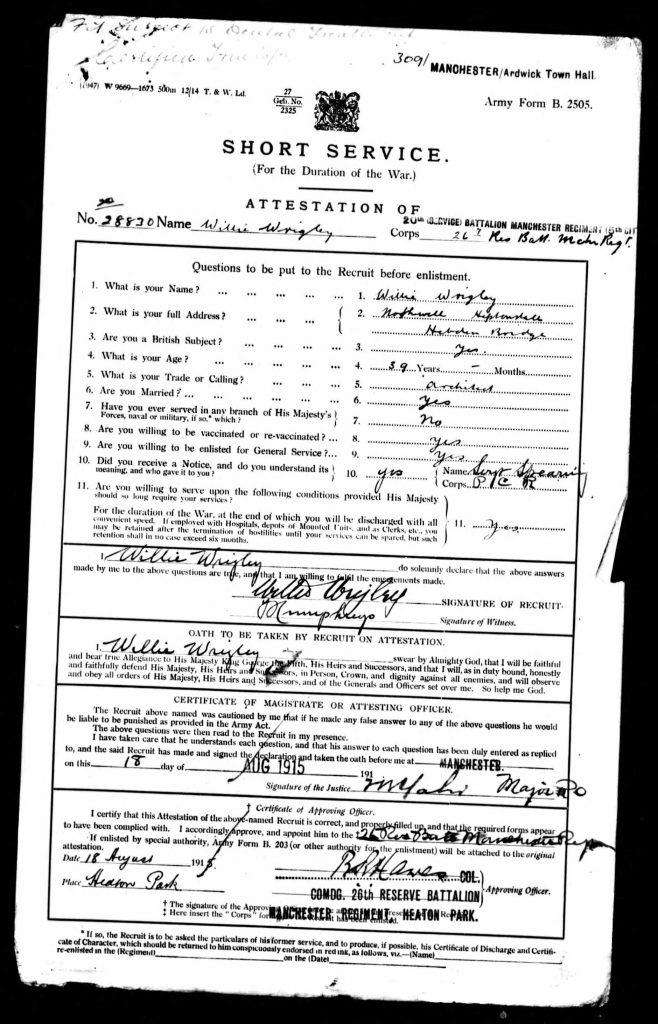
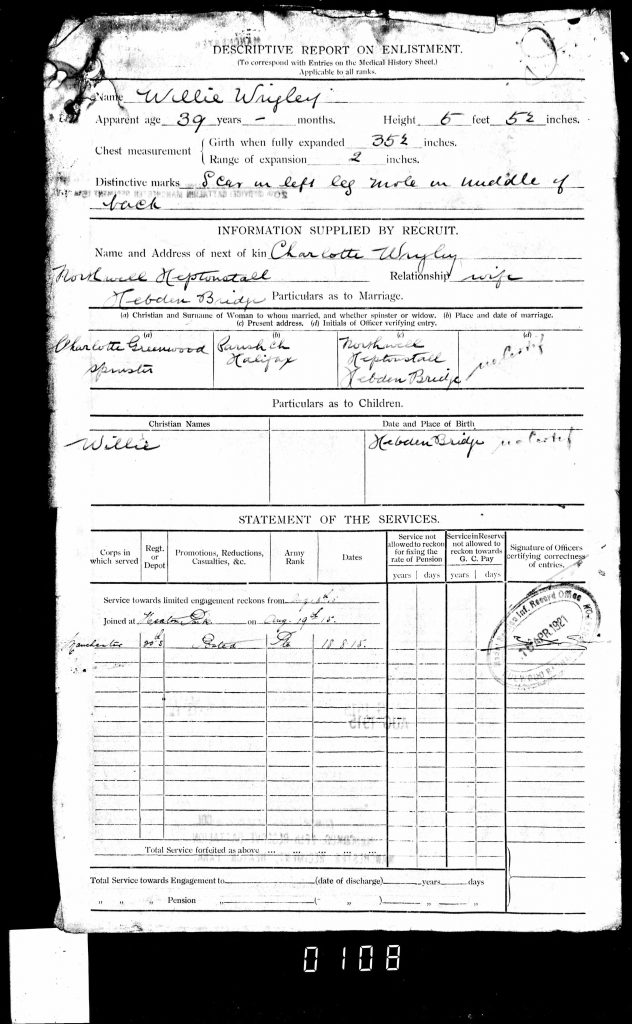
Elizabeth Ann Whitham
In the summer of 2016 I spent seven weeks in Calderdale researching my maternal grandmother’s ancestry. Though born and raised in the tiny village of Affetside in Lancashire I now live in Northern California and I was eager to make this trip to find out more about my heritage. For the previous seven years I had been doing as much research online as possible but I had come upon a puzzling fact: my great, great grandmother, Elizabeth Ann Whitham had been married twice, but had given the name of two different fathers on her two marriage certificates. First Elizabeth Ann married Ishmael Nutton at St John the Baptist church in Halifax on April 27, 1861. His residence at the time of marriage was Skircoat and Ishmael’s occupation was woolsorter. Ishmael’s father, James Nutton gives his occupation on the marriage certificate as woolsorter too. Elizabeth Ann, whose residence was Halifax, gives her father’s name as William Whitham with the space for his occupation left empty. In the 1861 census an Elizabeth Ann Whittam (born Heptonstall, 1841) is a cook at a large boarding school on Hopwood Lane, Park House. So far, so good. The school was run by the Farrar family. John Farrar (1813-1883) born at Heptonstall (just like Elizabeth Ann) was the “schoolmaster: Classical, commercial and mathematical.”(1861 census). Interestingly the road that joins Shaw Hill in Skircoat is Farrar Mill Road.
Ishmael died from alpaca poisoning (sorting alpaca wool) on March 17 1876. I found his grave at Christ Church Mt Pellon. Elizabeth Ann, now 40, was now head of the household living at 20 Haigh Street, Halifax, with her sons Charles 18, John 17 and William 14. She also has a lodger, James Hainsworth Leeming, eleven years younger than her. In 2016 I went to find her house. Haigh Street is still there, partially, but as ill-luck would have it the part I wanted has been demolished. It’s a street sandwiched between factory buildings, many of them derelict. Five years later Elizabeth Ann married James Leeming, a widower, originally from Horton near Bradford. But here, things get a little more complicated because she gives the name of her father not as William Whitham but as James Wrigley, a plasterer. Try as I might I just couldn’t figure this out. She’d given two different names for fathers on her two marriages. The simplest explanation is that I’d got the ‘wrong’ Elizabeth Ann, but that didn’t seem likely since the birth years were about the same and they’d both been born in Heptonstall. Completely at a loss I just happened to find a person online offering to help with people’s ancestral brick walls in Calderdale. I emailed Roger Beasley of the CFHS one evening in August, giving details of my predicament and, lo and behold by the time I woke up the next morning he had solved my mystery. He wrote: “I think I may have worked out why Elizabeth Ann Whittham gave both William Whittham and James Wrigley as her father. Her mother, Sally Farrar, daughter of James Farrar, married William Whittham in 1822. Their children were: Hannah (b.1828), Farrar (b.1831), John (b.1833), James Farrar (b.1837). William Whittham died in 1837. In the 1841 census there was a James Rigley, plasterer, living next door to the widow, Sally. It seems possible that Elizabeth Ann Whittham was the illegitimate daughter of Sally Whittham and James (W)rigley. I couldn’t find a baptism for Elizabeth Ann Whittham which was common for children born out of wedlock. However, I did find the record of her birth in 1840 on FreeBMD.” Perhaps Elizabeth Ann herself wasn’t aware of her true father when she married for the first time. But Roger Beasley’s email also contained two other very important facts. I’d been unable to trace Elizabeth Ann’s mother. Roger found her to be Sally Farrar of Heptonstall. When I got the church records for St Thomas’s Heptonstall there are 190 Farrar baptisms recorded! Roger did find a birth record of Elizabeth Ann in 1840 on FreeBMD in which she’s registered in Todmorden. When her birth certificate arrived from England I found that, sure enough, as Roger had surmised there is no father named on it. Her mother’s name is Sally Whitham nee Farrar and Elizabeth Ann was born at Lily Hall. I can’t help wondering if James Wrigley and his wife, knew that Sally was giving birth to James’s daughter literally in the next room – in Lily Hall.
So in September 2016 I embarked upon some research into the family of James Wrigley. After all, if these facts are correct he is my great, great, great grandfather! I found two online Wrigley family trees with the correct James Wrigley, of Heptonstall. I contacted both tree owners and they both live in New Zealand. James was one of eight children. One of his brothers was Abraham and remarkably there was a photo of Abraham taken with his own son John. From Grace Hanley in New Zealand I found out that “John came to NZ in 1863, Edmund in 1865 and Hannah, James and their mother Sally arrived in NZ, 1883.” James Wrigley, Elizabeth Ann’s biological father had married Mary Pickles on March 15th 1840. One of James and Mary’s children was Mally Wrigley. She married James Barker of Water Barn, Rossendale on July 14, 1866 in Heptonstall. Mally and James were both weavers when they married but by 1871 and 1881 he was a cotton operative.
I will return to Calderdale this summer to further my research and would love to meet up with people who may have recognized some of their ancestors in my story.
With many thanks to Roger Beasley.
Searching for relatives of Willie & George Wrigley & Gwendoline Flynn nee Wrigley all born in HB c.1900. I am daughter of George trying to trace any family members still in the area.
Elizabeth West (nee Wrigley) <west.millbrook@tinyworld.co.uk>
Northampton, UK – Saturday, February 10, 2001 at 23:20:11 (GMT)
He was in jail [1901, 1911].
With help of ROOTSCHAT members, the following story has emerged
In December 1905, Willie was brought before Todmorden magistrates because, after a fortune had been left to him, he had spent £900 in a short time, by drinking. He had then run away and left his family – incurring welfare charges of £40 on the rates, and written threatening letters to his wife.
He was cohabiting with another woman in Southport, where he was arrested.
In June 1907, he was charged with neglecting his wife & children, and the maximum sentence of 3 months’ hard labour, was passed
The family lived at 8 Old Gate, Hebden Bridge [1911]
Walsh & WrigleyArchitects. Partnership established in 1894 by Joseph Frederick Walsh and Willie Wrigley. The business lasted 16 months.
Update – April 2024
Last week I attended a lecture the the Hebden bridge Local History Society by local historian David Cant entitled The Farm that Moved. I was truly amazed to find a mention of Willie Wrigley. Here is a write up of the lecture from the society’s webpage.
‘Hollin Hey, just off Cragg road near Mytholmroyd, was one of the oldest of the houses that dot the hills around Hebden Bridge, but by the end of the nineteenth century it had moved the length of a field to its current position. David Cant, local historian and vernacular buildings specialist, followed a trail of evidence in documents and stones to tell the later history of the house.
The old house, as recorded in both a drawing and a photograph shortly before it was demolished, was a fine stone building with some of the typical architectural details of its period, such as rounded mullion windows, finials on the roof and a door-head dated 1572. So what happened? David traced the history of the farm and buildings from when it was an auction lot in 1894. Originally on sale as two separate farms (Great and Little Hollin Hey) the lots were combined, and the estate was purchased by a Mr Edward Helliwell from Broadbottom in Mytholmroyd, for £1745. Soon after purchasing the property he applied to erect new buildings and demolish the old ones.
Census documents show that from at least the 1840s, the two farms had been home to several households, and most occupants had not been farmers. So perhaps when Mr Helliwell planned to make Hollin Hey more productive he decided to start with a new built farm house and barn. A rare survival is a 19th century plan of part of the old building, an architect’s apprentice-piece completed just before it was demolished, full of interesting detail such as the original timbers visible inside, and a decorative twisted chimney top. The plans also reveal that the house had been split into two or more dwellings.
Plans drawn up by Hebden Bridge architects Walsh and Wrigley show the new house and barn were designed to provide both more modern living quarters and to improve the profitability of the farm. The plan for the barn incorporates ‘mistals’ (standing places) for far more cattle than would have been kept previously. The population growth in Halifax meant that milk production was now very profitable. The house attached to the barn also offered a more genteel style of living than the shared dwellings of the old farm. There was a living room and parlour for the family, plus a kitchen and scullery, and a second living room possibly for a housekeeper and servants. There were two sets of stairs, one to the completely separate servant quarters, the other to the family bedrooms and the great innovation of a bathroom and w.c.
The building as it now stands reveals that they were keen to maintain the links with the past as well as look to the future. The arched window mullions were replicated and stone and timbers from the demolished house re-used. The stone fireplace, the gable coping stones, and the roof finials were retained. The new owner clearly wanted to give a nod to the past in his new house – the original door head with its 1572 date is incorporated, with an added inscription ‘Rebuilt 1896 EH ‘ declaring Helliwell’s pride in the farm that moved.’

Further update: June 6, 2020
I was trying to find information on the location of Green Springs on Widdop Moor today when up popped a comment on RootsChat. Oh my! It took my by surprise: Sheffield daily telegraph 4th nov 1861. Murder and Suicide by a Mother Mytholmroyd On Friday last, at midday, a most awful tragedy was perpetrated at Hill House, Wadsworth, Mytholmroyd, by a married woman, named Greenwood, wife of Mr. Greenwood, farmer. The following are a few of the particulars. It appears that during the forenoon Mr. Greenwood had gone to Mytholmroyd with a week’s butter, and while away his wife cut the throat of her little daughter, about five years old, after which she cut her own throat, and ran out bleeding profusely into the house of a neighbour, named Sutcliffe, and then ran back into her own house. She still had the razor in her hand. Sutcliffe took it from her, and the mother pointed to the child in an adjoining room, with its head almost severed from its body. It would seem she had had two razors at work; one was also lying on the table, opposite the looking glass, covered with blood, along with two empty razor cases. The house presented more the appearance of a slaughter-house than human dwelling, such was the quantity of blood on the floors. The little girl’s hands were tied with a shred of cotton lining. Mrs. Greenwood has been in a desponding state of mind for some time, but not so much so as to cause much alarm. Mrs. Greenwood was still being attended by Drs. Fielden and Howard, but no hopes are entertained of her recovery. Our correspondent adds, in postscript : “Since the above was written, it is reported that Mrs. Greenwood is dead also.” The story made many newspapers even reaching Bristol and places further south. Charlotte Greenwood, who married Willie Wrigley was the daughter of James Greenwood and his second wife, Elizabeth Jackson, but Charlotte had been born in the house where this awful tragedy occurred. I walked along Heights road yesterday, looking down with pleasure at Hill House and its commanding position and recalling my visit and conversation with the current owner. I know that the place will hold different thought for me whenever I see it perched on the hill above Mytholmroyd and I can’t help but wonder if the current owner knows of this story about her home.
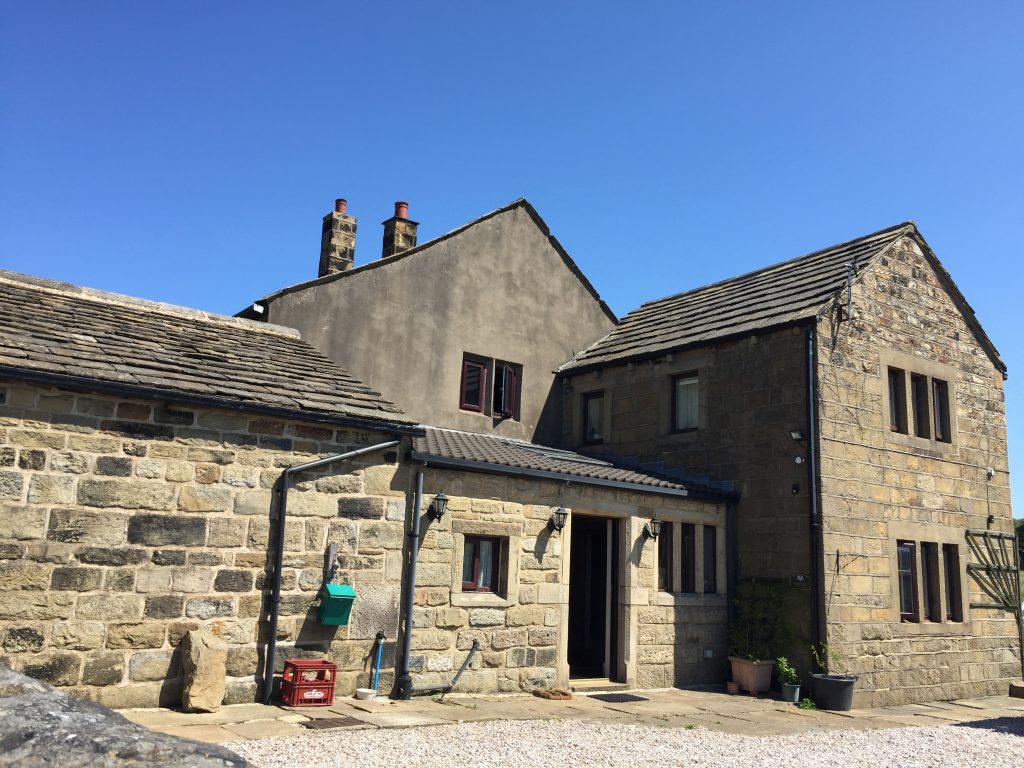
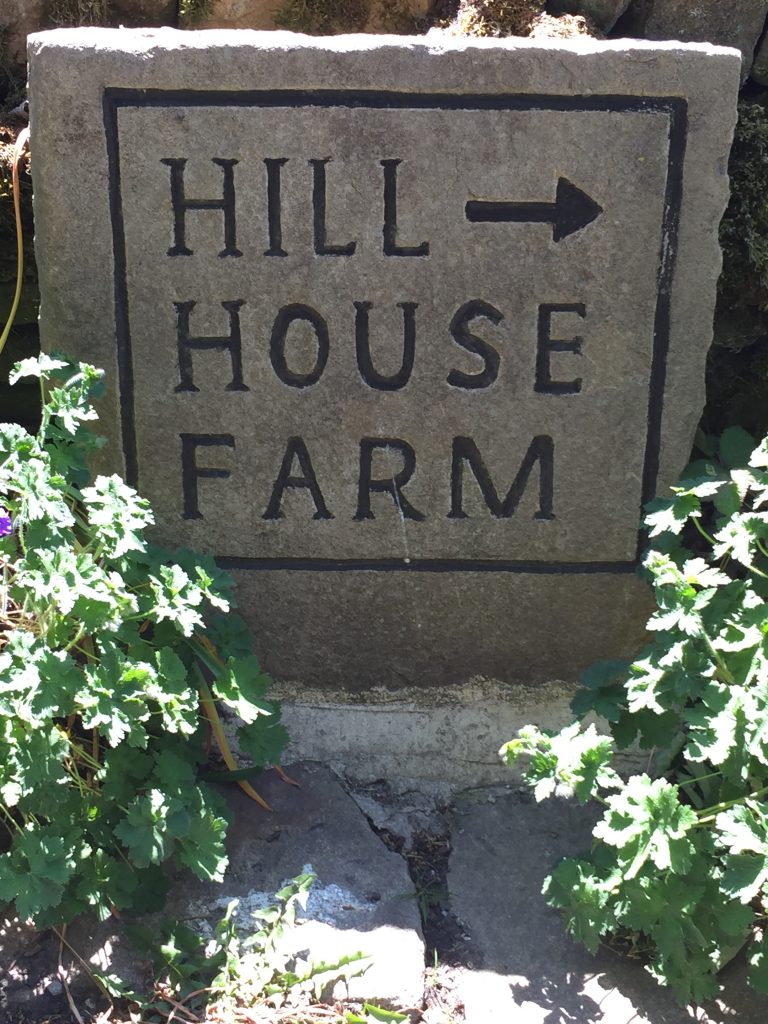
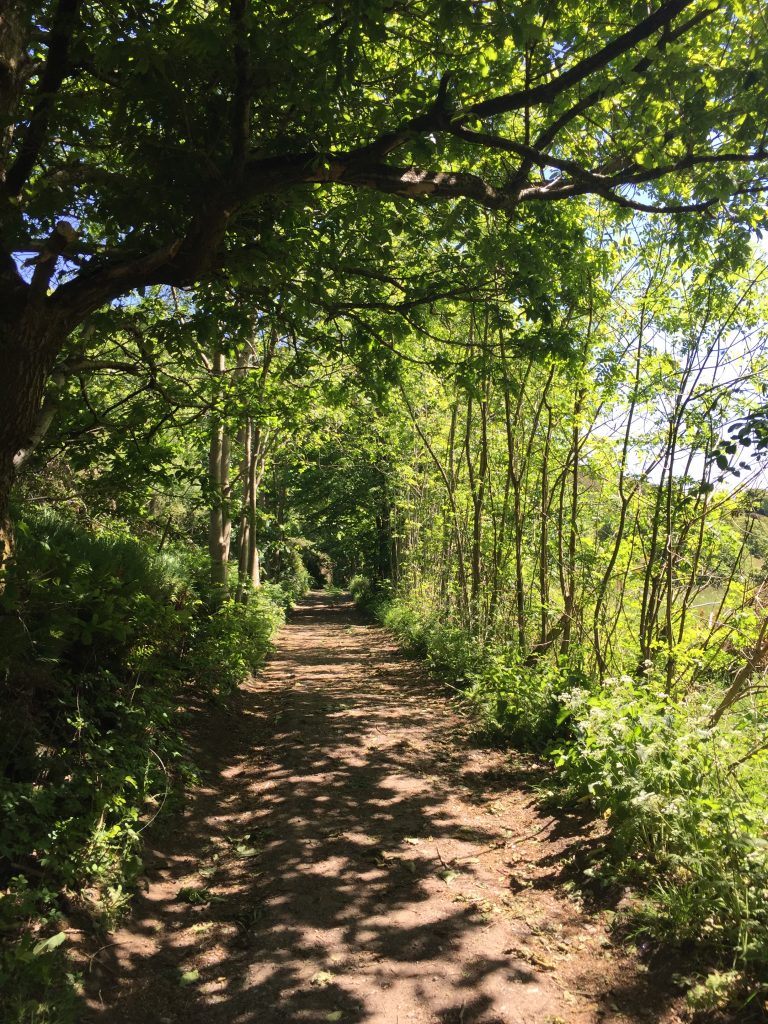
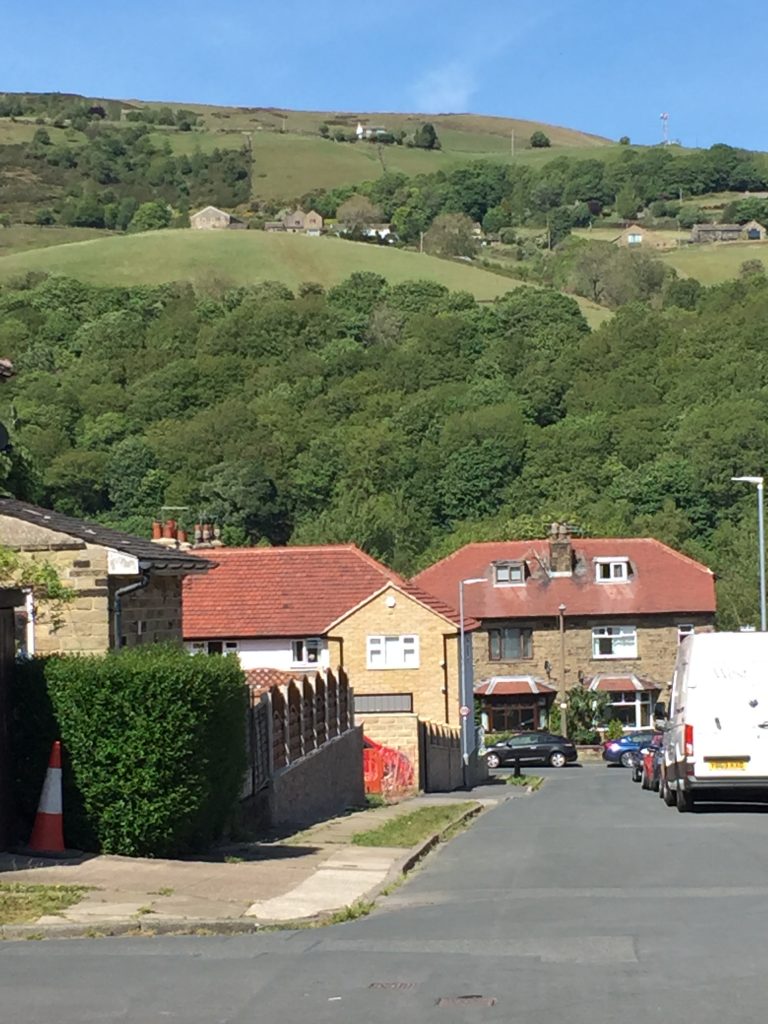
I am related to Charlotte Greenwood. My Grandad Abraham Greenwood was her half brother. They had the same father but different mother’s. Would love to discuss more with you. I remember meeting Charlotte in about 1952 when she lived in Hebden Bridge and her sister Rachel who lived in Mytholmroyd.
Yours sincerely
June Greenwood
PS I’m 83 years young
June,
Profuse apologies for not seeing your comment earlier. As it happens I walked past Charlotte’s birthplace, Hill House, just yesterday. I would love to connect with you and hear your stories of Charlotte and her family.
Heather
Please call me on 07719532492
It will be nice to talk to you Heather
Cheers June
My gt grandfather Sam Wrigley was Willie Wrigley’s brother. Thanks for posting all this fascinating information. I did not know the details behind Willie’s prison sentence. Do you know anything about what happened to Willie eventually?
I have a lot of information about the Wrigley ancestry. I have a photo of Willie if you’d like a copy sent. Your supposition about James Wrigley and his illegitmate child is also of interest. James is also in my direct line.
You may be interested to know that Willie was not the only reprobate. Sam, my gt grandfather left his wife and daughter (my grandmother) and subsequently committed bigamy by marrying the woman he had left his family for.
Be interested in hearing from you.